|
September 1976 QST
 Table of Contents Table of Contents
Wax nostalgic about and learn from the history of early electronics. See articles
from
QST, published December 1915 - present (visit ARRL
for info). All copyrights hereby acknowledged.
|
That would be President Ford in the
background atop the platform, behind where the OSCAR ground station was set up.
He was there as part of the dedication of the new
National Air &
Space Museum in Washington, D.C., in 1976. The event was part of the nationwide
series of bicentennial celebrations marking America's founding with the signing
of the
The unanimous Declaration of the thirteen united States of America.
Apollo 11 astronaut
Michael Collins
directed the event. The Space Race was in its heyday and most people were still
in awe of anything related to spacecraft - both manned and unmanned. Just about
anyone other than a Ham radio operator believed communicating with a satellite was
the exclusive domain of governments, so the presence of
AMSAT (amateur radio satellite)
with a portable ground station set up for reception of a pre-recorded broadcast
from President Ford constituted a real eye-opening. As this 1976 QST article
points out, OSCAR 7
proved to be tough competition for the Oval Office's attention.
The Udvar-Hazy
Center in Chantilly, Virginia, opened in 2003 as a secondary location. I have
visited both museums. A couple full days would be required to really take in all
that is on display.
OSCARs Help Dedicate New Air and Space Museum
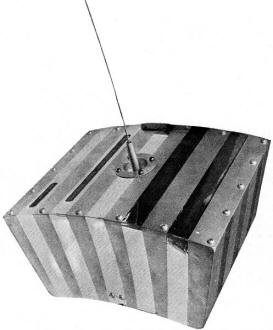
The first OSCAR: On Dec. 12, 1961,just four years after the first
Sputnik, radio amateurs had their own satellite - a 10-pound package that transmitted
HI HI HI in Morse code for three weeks. It was the world's first non-government
satellite.
OSCAR 1 inside, OSCAR 7 outside, help dedicate Smithsonian's awe-inspiring National
Air and Space Museum.
By Joel p. Kleinman*
Sitting unpretentiously alongside its larger cousins, the backup of the OSCAR
1 satellite was an impressive part of the spanking new National Air and Space Museum
in Washington, DC. It was thus fitting that OSCARs 6 and 7 transmitted parts of
President Ford's remarks at the Museum's dedication July 1.
A portable ground station designed and operated by AMSAT Executive Vice President
Tom Clark, WA3LND, was used to transmit a tape of the President's speech just 15
minutes after he delivered it.
While AMSAT President Perry Klein, K3JTE, assisted with the transmission, Project
OSCAR's Paul Schuch, WA6UAM, aimed the antenna and simultaneously shooed curious
spectators away from the cables.
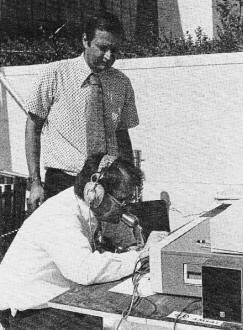
WA3LND (transmitting) and K3JTE QSO via OSCAR 7. (WA40GU photo)
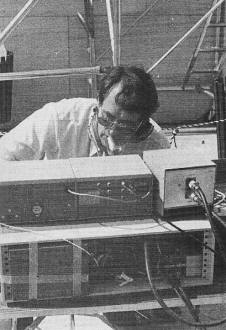
WA3LND mirrors the intensity of attempting a contact with a satellite
speeding overhead. (WA4DGU photo)
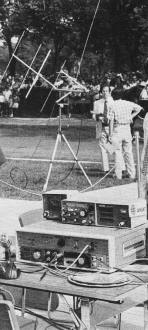
The battery-operated portable OSCAR gear. Part of the several
thousand spectators who lined up across the street to watch the President are visible
in the background. (K2KHR/WB4UOX photo)
Loud and Clear
Interference marred the initial attempt, via OSCAR 6, but OSCAR 7 followed just
20 minutes later. As it rose up over the trees lining Constitution Avenue, the tape
of the President's speech came back loud and clear. Traveling at 15,000 mph over
the western Great Plains, the satellite soon passed behind the Washington Monument
and out of range, but several QSOs were made, ranging from VE3SAT in Ontario and
a station in Illinois to NN3SI, the new station at the Smithsonian's Museum of History
and Technology barely a half mile away.
Although competing for attention with the President and the Viking space-craft
circling Mars (which beamed back the radio signal that cut the ceremonial ribbon),
OSCAR 7's signals attracted a great deal of interest from journalists and tourists
alike. Two ARRL representatives, Club and Training Manager Charles Harris, WB2CHO
and this writer, who works with the Oscar Educational Program, briefed members of
the national and local media on the OSCAR satellites and the mechanics of the transmission
that had sent the President's words across the U.S. and Canada. Some had heard of
OSCAR, most hadn't; but all who stopped by the station came away with a new perspective
on amateur radio.
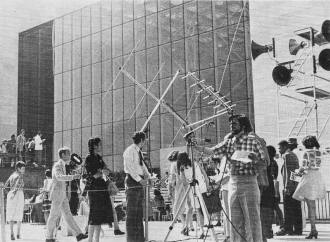
As WA6UAM adjusts the antenna, members of the press gather around
the OSCAR station, hidden behind him. (K2KHR/WB4UOX photo)
The ground station, set up just 100 feet from the speaker's platform, was built
with financial assistance from the Northern California DX Foundation, which hopes
to use similar terminals to expand OSCAR communications links with foreign countries.
Following the outdoor dedication ceremony, the first of the estimated seven-million
persons who will visit the three-block-long, 40-million dollar museum in its first
year poured through its doors. Those who make their way to the OSCAR display, in
the section reserved for communications satellites, will be able to hear a tape
recording describing the OSCAR program and the space-age hobby that spawned it -
amateur radio.
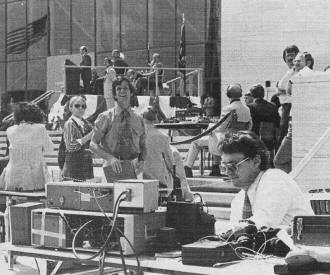
The portable OSCAR station competes with the President for spectator
attention - fairly successfully. (WA4DGU photo)
* OSCAR Educational Program Assistant, ARRL
Posted October 16, 2020
|














